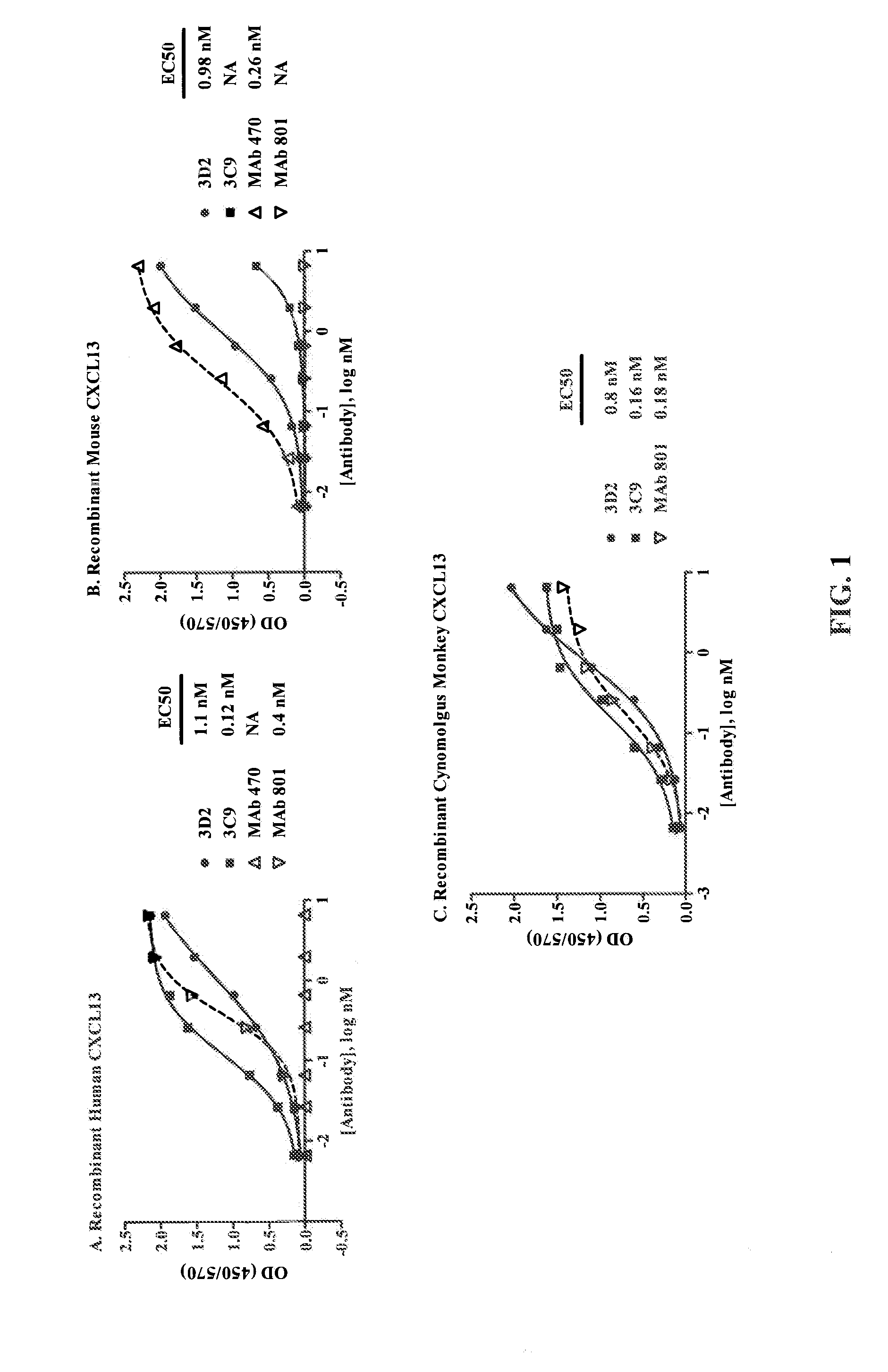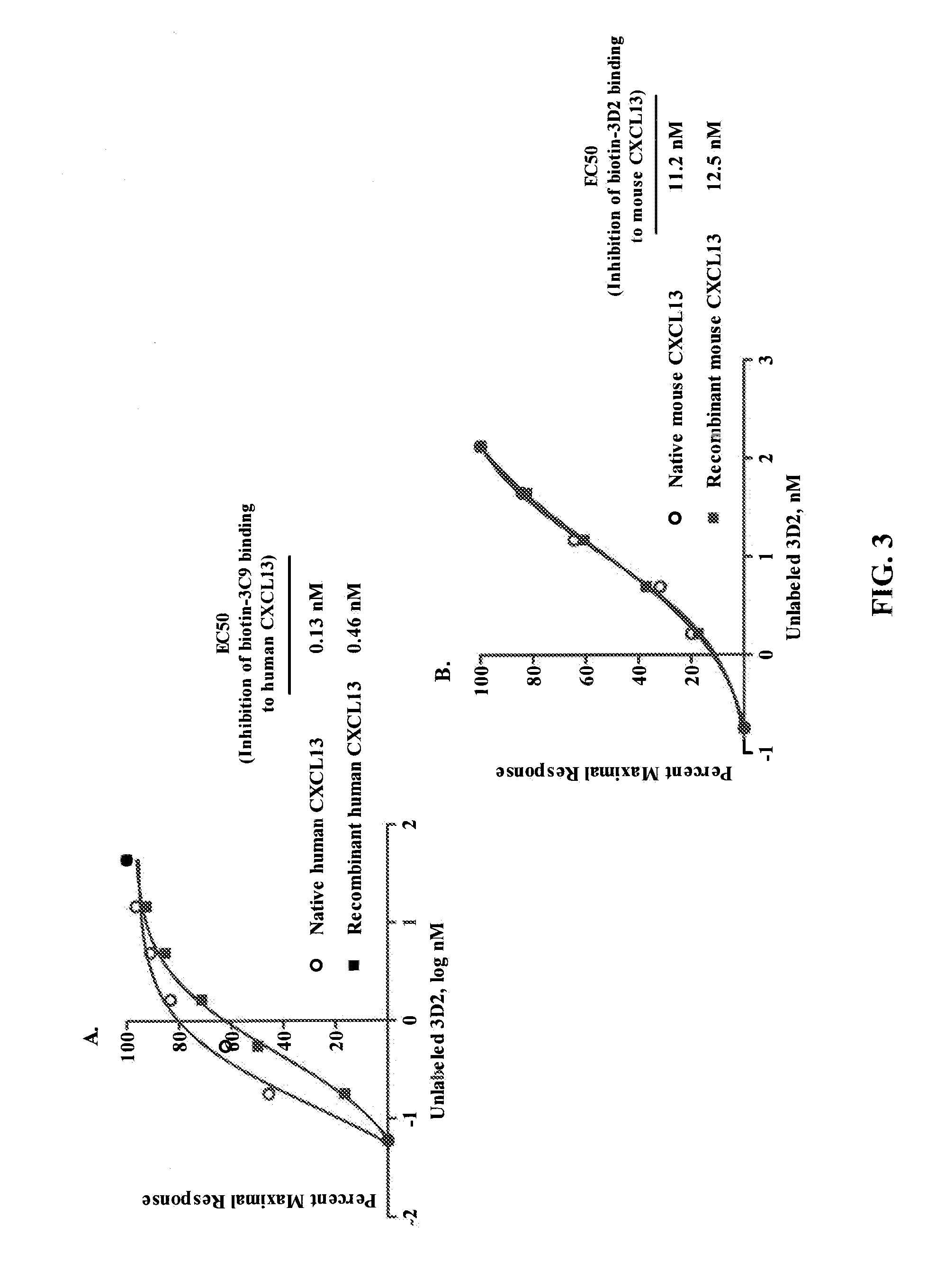Anti-cxcl13 antibodies and methods of using the same
a technology of anti-cxcl13 and antibodies, which is applied in the field of anti-cxcl13 antibodies, can solve the problems of abnormally small germinal centres in the lymph nodes and spleens, misplaced germinal centres, etc., and achieve the effect of reducing or inhibiting gastric lymphoid follicles
- Summary
- Abstract
- Description
- Claims
- Application Information
AI Technical Summary
Benefits of technology
Problems solved by technology
Method used
Image
Examples
example 1
Selection and Characterization of Mouse Antibodies Specific for Human CXCL13
[0279]Hybridoma generation. Swiss Webster mice were immunized with Keyhole limpet hemocyanin (KLH)-conjugated human CXCL13. After three immunizations, spleen was harvested from the mouse with the highest anti-CXCL13 titer and hybridomas were generated by fusion of spleen cells with SP2 / 0 myeloma cells using standard procedures.
[0280]Hybridoma clones were screened by ELISA for binding to human and mouse CXCL13 protein. ELISA plates were coated with about 100 nM of human (Peprotech: #300-47) or mouse (Peprotech: #250-24) CXCL13 protien overnight at room temperature (RT). After the plates were washed and blocked, dilutions of standard anti-CXCL13 antibodies (R&D Systems: rat anti-mouse MAb 470 and mouse anti-human MAb 801) or hybridoma supernatant were added and incubated for 1 hour at RT. The plates were washed and secondary antibodies (goat anti-mouse IgG-HRP for hybridoma supernatant and MAb 801; donkey anti...
example 2
Anti-CXCL13 Antibody Inhibition of Human B-Cell Migration
[0288]Inhibition of CXCL13 function, e.g., B-cell migration, was evaluated using established models that simulate B-cell migration in both human and mouse systems. Migration towards a non-CXCL13 chemokine, SDF-1α (a.k.a. CXCL12), was used as a control to confirm specificity of anti-CXCL13 antibody on inhibition of B-cell migration. Thus, anti-CXCL13 antibodies were tested for inhibition of human CXCL13-induced migration and the absence of an effect on SDF-1a-induced migration.
[0289]Inhibition of human B-cell migration towards human CXCL13. The effect of 3D2, 3C9, and MAb 801 on human CXCL13-induced B-cell migration was tested.
[0290]Two clonal cell lines, human pre-B-697-hCXCR5 and human pre-B-697-hCXCR4, were used to assess the effects of anti-CXCL13 antibodies on recombinant human CXCL13-dependent migration and recombinant human SDF-1α-dependent migration, respectively. Transwell tissue culture-treated plates with 8 μm pore s...
example 3
Anti-CXCL13 Antibody Inhibition of CXCL13-Mediated Endocytosis of Human CXCR5
[0294]Inhibition of CXCL13 chemokine function, e.g., CXCL13-mediated endocytosis of CXCR5 receptor, with anti-CXCL13 antibodies was evaluated using an established model for human CXCL13-mediated endocytosis of human CXCR5 receptor (Burke et al., Blood 110:2216-3325 (2007)).
[0295]Inhibition of CXCL13-mediated endocytosis of human CXCR5 receptor. Binding of a chemokine to its chemokine receptor leads to internalization of the ligand-receptor complex with subsequent activation of intracellular signaling cascade (Neel et al., Chemokine and Growth Factor Reviews 16:637-658 (2005)). The flow-based method described in Burkle et al. was adapted to determine the ability of 3D2 to inhibit CXCL13-mediated CXCR5 receptor internalization in both human and mouse cells. For the human CXCL13-mediated endocytosis, hCXCL13 was combined with 3D2, MAb 470 or Mouse IgG (at concentrations 0, 33, 66, 132, 264, and 528 nM) and inc...
PUM
| Property | Measurement | Unit |
|---|---|---|
| diameter | aaaaa | aaaaa |
| pore size | aaaaa | aaaaa |
| wavelengths | aaaaa | aaaaa |
Abstract
Description
Claims
Application Information
 Login to View More
Login to View More - R&D
- Intellectual Property
- Life Sciences
- Materials
- Tech Scout
- Unparalleled Data Quality
- Higher Quality Content
- 60% Fewer Hallucinations
Browse by: Latest US Patents, China's latest patents, Technical Efficacy Thesaurus, Application Domain, Technology Topic, Popular Technical Reports.
© 2025 PatSnap. All rights reserved.Legal|Privacy policy|Modern Slavery Act Transparency Statement|Sitemap|About US| Contact US: help@patsnap.com



